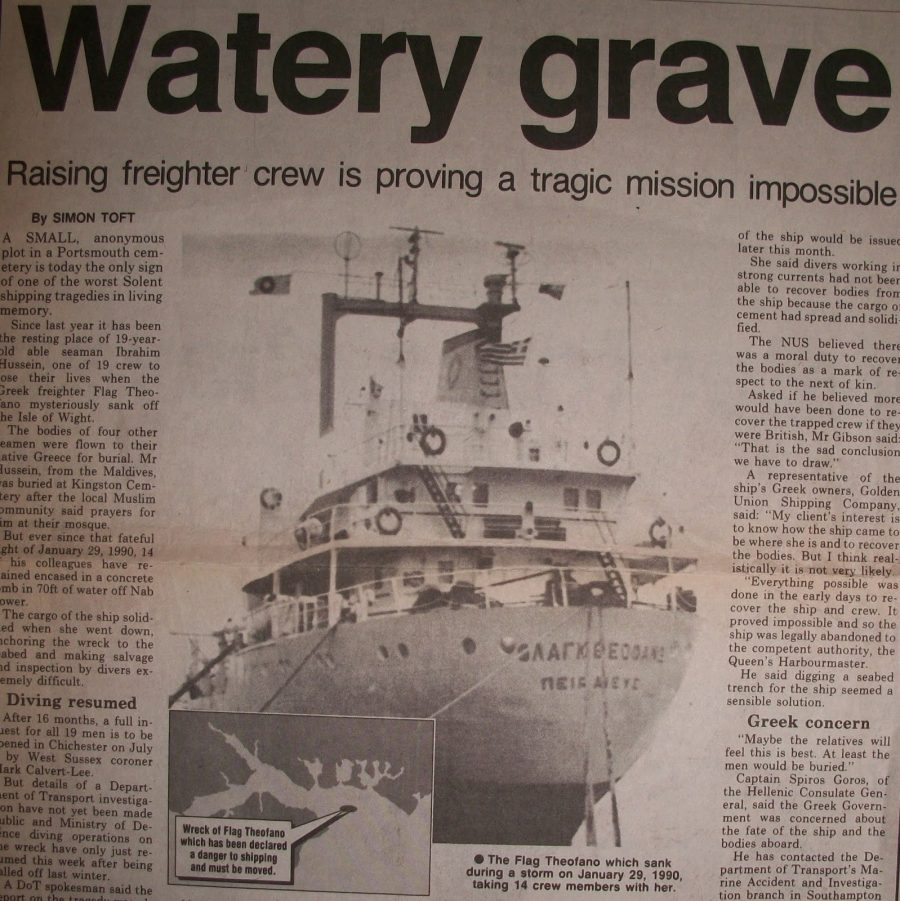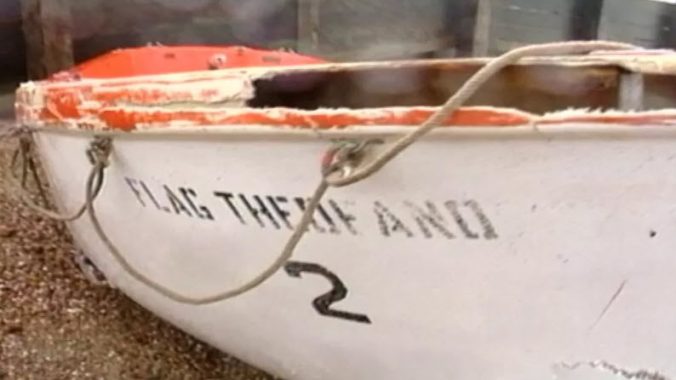By now, a lot of people will be much more aware of the story of the sinking of the Flag Theofano on 29th January, 1990 in the approaches to the Eastern Solent. Much of this awareness is due to the publication in 2022 of the book “The Forgotten Shipwreck” by commercial diver Martin Woodward MBE, and the campaigning that he and Steve Hunt undertook to raise public awareness of the tragedy.
Having read the book, the Marine Accident Investigation Board (MAIB) Summary Report and other contemporary reports, I believe there are a number of questions that remain mysteriously unanswered. A total of 19 men lost their lives that night, the largest peacetime loss of life in the Solent waters in recent history. Only five bodies were recovered, and the body of Ibrahim Hussein who was buried in Portsmouth was finally given a memorial headstone in 2022 thanks to the campaigning by Steve Hunt and funding from Southampton Ship Owners Association. The remaining 14 bodies are almost certainly still in the wreck, which is intact and only 3.8 miles from shore.
Piecing together the various sources of information, it is almost certain that there were multiple factors that caused the wreck rather than any single cause. The most significant factor was the shift in the dry powder cargo which caused the sudden capsize, but a shift doesn’t happen spontaneously. Something has to cause the cargo to shift.
Let’s wind back a bit. This vessel had already made 18 round trips to Southampton since refitting as a bulk cement carrier, but the captain had recently been replaced so the new captain, Ioannis Pittas was relatively inexperienced with the route in past the Nab Tower.
That night, after arriving at the Nab Tower, they were instructed by Southampton VTS to anchor in St. Helen’s Roads for the night. An experienced captain would have known it was safe to take a short cut from the Nab to St. Helen’s Roads directly across New Grounds. Instead, Captain Pittas followed the buoyed shipping channel as far as Dean Tail. This would have been fine, except for what happened next.
According to Martin Woodward who dived the wreck immediately after the sinking and surveyed the wreck and surrounding seabed extensively, he is in no doubt that the vessel overshot the turn to port at Dean Tail and temporarily snagged the buoy under the rudder. This was enough to slow and heel the vessel, triggering the cargo shift and sudden capsize. The full details supporting this assessment are very well explained and illustrated in the book, with supporting evidence.
This could be left as a tragic accident if it wasn’t for some significant, unanswered questions which remain. If anyone wants to come forward and provide explanations, I will willingly publish them so the full story can be told at last.
- The New Grounds buoy was reported to be out of position by 350 metres to the north. If Captain Pittas was using this buoy to confirm his own position, it would have put him further north than was safe and in a collision course with the Dean Tail buoy. Why were there no navigational warnings issued by KHM Portsmouth if the buoy had been reported out of position?
- The Dean Tail buoy was reported as unlit on the night of the accident. Again, why was there no “Notice To Mariners” issued?
- Flag Theofano was called three times during the night by Southampton VTS with no reply, yet no further action was taken. Why didn’t that cause concern? The Bembridge Lifeboat was in the area and could have been asked to check.
- Evidence from the wreck of a waterline collision with a metal object, the seabed scour from the six ton buoy sinker and the report from THV Patricia indicates that the Dean Tail buoy was badly collision damaged and had been dragged by a considerable force. This is denied by the MAIB Report, yet the buoy was removed and replaced as soon as the weather eased after the fateful storm. If it wasn’t damaged, why was it removed so quickly? And as it was a vital piece of evidence for the MAIB enquiry, why did it disappear?
- Only five bodies were recovered out of the 19 crew. We can only assume most if not all of the remaining 14 are inside the wreck. No permission was given to recover these bodies even though divers could access some of the accommodation areas. The recovery operation concentrated on removing the cement, and 60 tonnes were extracted. If it was possible and affordable to recover 60 tonnes of cement, why were 14 bodies left in the same wreck?
Having read the available reports and spoken to individuals involved at the time, I am now in no doubt that the most likely cause of the sinking was a combination of:
- the route taken by an inexperienced captain;
- the buoys being unlit or out of position causing the ship to take the wrong course;
- leading to a collision and entanglement with the Dean Tail buoy;
- which turned the vessel broadside to the waves;
- which resulted in the ship heeling badly;
- causing a cargo shift and capsize.
Although this might be seen as a “perfect storm” of unfortunate events, the main question in my mind is around the apparent cover-up of the collision with the Dean Tail buoy. Why was that? What was there to hide?

In addition, I think the callous disregard for the bodies and the families involved is inexcusable. Contemporary press clippings indicate that the bodies are “encased in concrete”, but the crew accommodation is in a different part of the boat from the cargo hold area containing the solidified cement. This makes me wonder who was giving this false information to the press? The ship has now rolled almost upside down and the crew section may be crushed, but that isn’t what we were told. If there was a tragedy of this scale on land, would the authorities have left 14 bodies under a collapsed tower block in Portsmouth, and bulldozed over them? There would have been an outrage. Surely it is still possible for the remains to be recovered, or at least an attempt be made. At a minimum, I think the MAIB should review their report which given the severity of the tragedy is superficial to say the least.
These are my own conclusions, and I welcome any further information if it helps with the explanation of the events surrounding this tragedy.
Neville Merritt
December 2022

Leave a Reply
You must be logged in to post a comment.